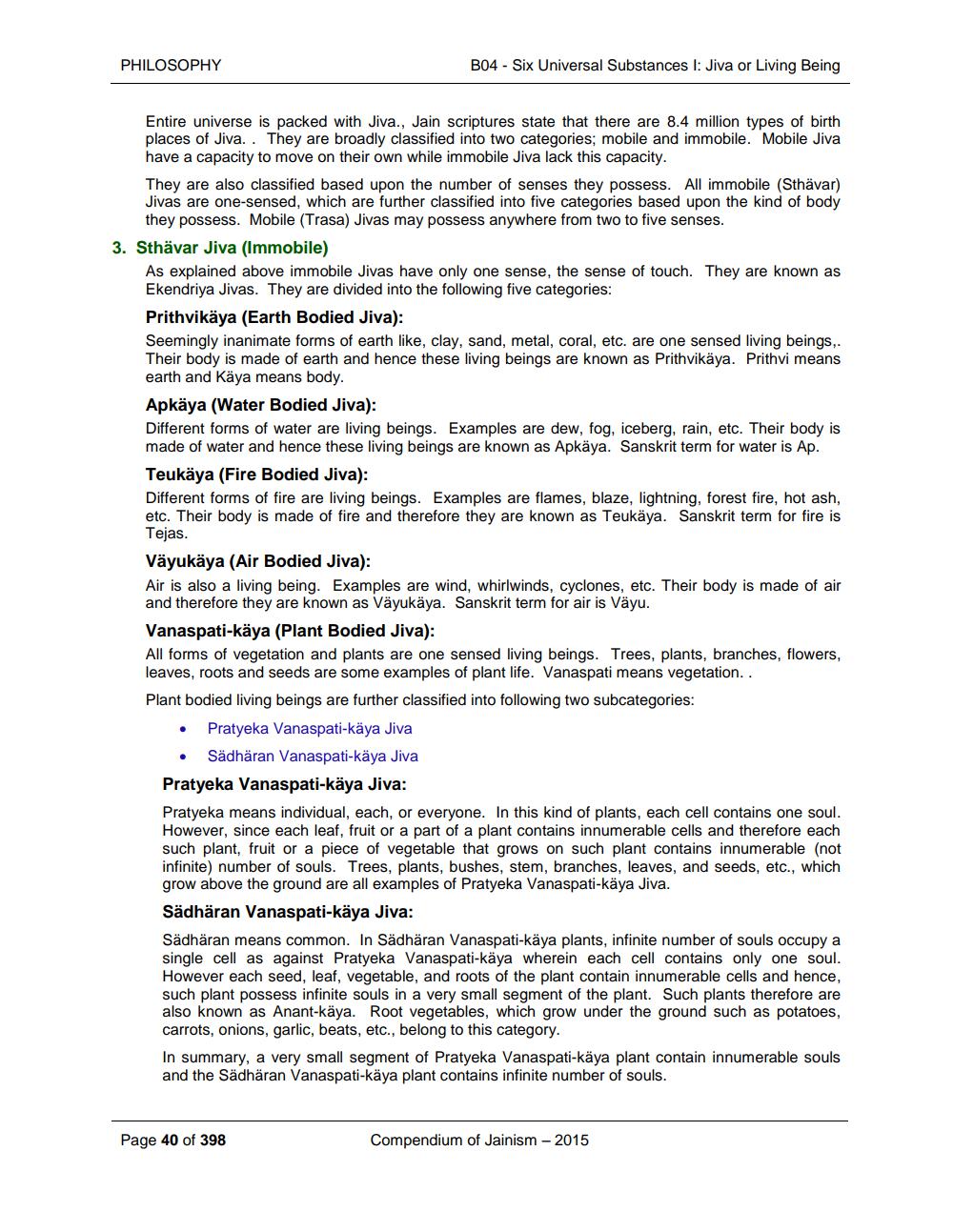________________
PHILOSOPHY
Entire universe is packed with Jiva., Jain scriptures state that there are 8.4 million types of birth places of Jiva. . They are broadly classified into two categories; mobile and immobile. Mobile Jiva have a capacity to move on their own while immobile Jiva lack this capacity.
B04 Six Universal Substances I: Jiva or Living Being
They are also classified based upon the number of senses they possess. All immobile (Sthävar) Jivas are one-sensed, which are further classified into five categories based upon the kind of body they possess. Mobile (Trasa) Jivas may possess anywhere from two to five senses.
3. Sthävar Jiva (Immobile)
As explained above immobile Jivas have only one sense, the sense of touch. They are known as Ekendriya Jivas. They are divided into the following five categories:
Prithvikaya (Earth Bodied Jiva):
Seemingly inanimate forms of earth like, clay, sand, metal, coral, etc. are one sensed living beings,. Their body is made of earth and hence these living beings are known as Prithvikäya. Prithvi means earth and Käya means body.
Apkäya (Water Bodied Jiva):
Different forms of water are living beings. Examples are dew, fog, iceberg, rain, etc. Their body is made of water and hence these living beings are known as Apkäya. Sanskrit term for water is Ap. Teukaya (Fire Bodied Jiva):
Different forms of fire are living beings. Examples are flames, blaze, lightning, forest fire, hot ash, etc. Their body is made of fire and therefore they are known as Teukäya. Sanskrit term for fire is Tejas.
Väyukäya (Air Bodied Jiva):
Air is also a living being. Examples are wind, whirlwinds, cyclones, etc. Their body is made of air and therefore they are known as Väyukäya. Sanskrit term for air is Väyu.
Vanaspati-käya (Plant Bodied Jiva):
All forms of vegetation and plants are one sensed living beings. Trees, plants, branches, flowers, leaves, roots and seeds are some examples of plant life. Vanaspati means vegetation..
Plant bodied living beings are further classified into following two subcategories:
Pratyeka Vanaspati-kaya Jiva
Sädhäran Vanaspati-käya Jiva
Pratyeka Vanaspati-käya Jiva:
Pratyeka means individual, each, or everyone. In this kind of plants, each cell contains one soul. However, since each leaf, fruit or a part of a plant contains innumerable cells and therefore each such plant, fruit or a piece of vegetable that grows on such plant contains innumerable (not infinite) number of souls. Trees, plants, bushes, stem, branches, leaves, and seeds, etc., which grow above the ground are all examples of Pratyeka Vanaspati-käya Jiva.
Sädhäran Vanaspati-käya Jiva:
Sädhäran means common. In Sädhäran Vanaspati-käya plants, infinite number of souls occupy a single cell as against Pratyeka Vanaspati-käya wherein each cell contains only one soul. However each seed, leaf, vegetable, and roots of the plant contain innumerable cells and hence, such plant possess infinite souls in a very small segment of the plant. Such plants therefore are also known as Anant-käya. Root vegetables, which grow under the ground such as potatoes, carrots, onions, garlic, beats, etc., belong to this category.
In summary, a very small segment of Pratyeka Vanaspati-käya plant contain innumerable souls and the Sädhäran Vanaspati-käya plant contains infinite number of souls.
Page 40 of 398
Compendium of Jainism - 2015




